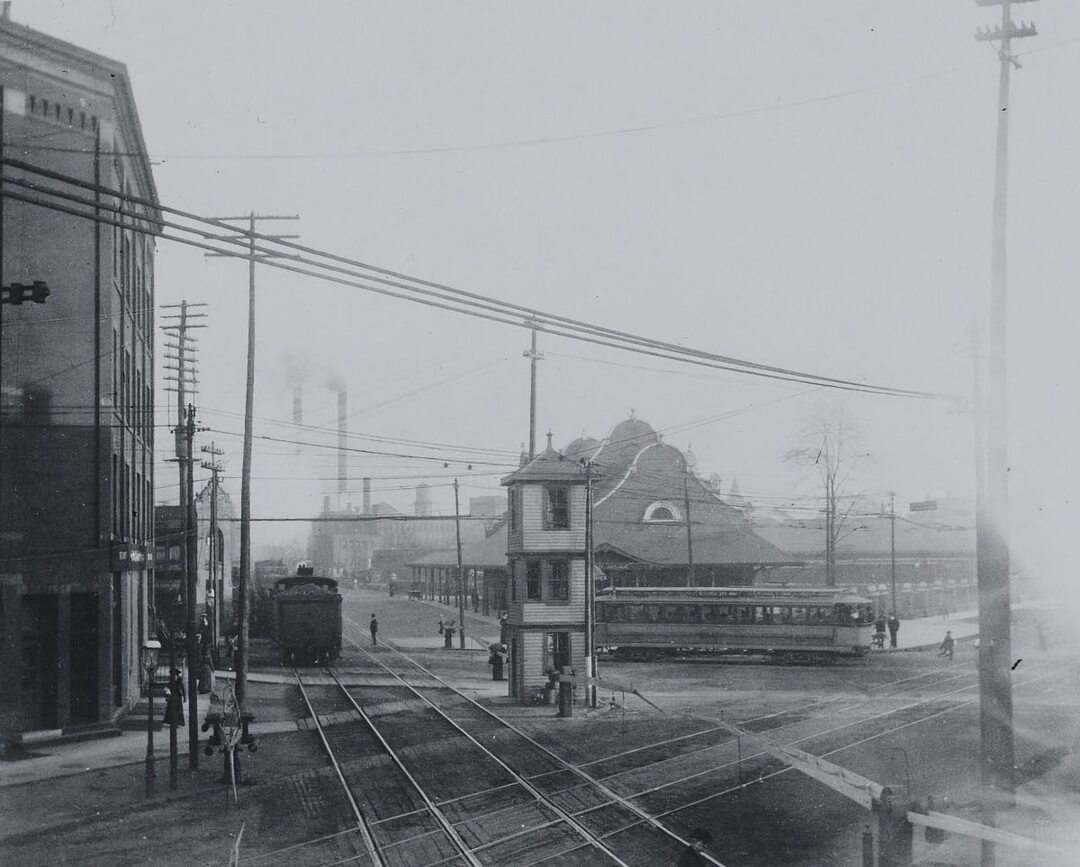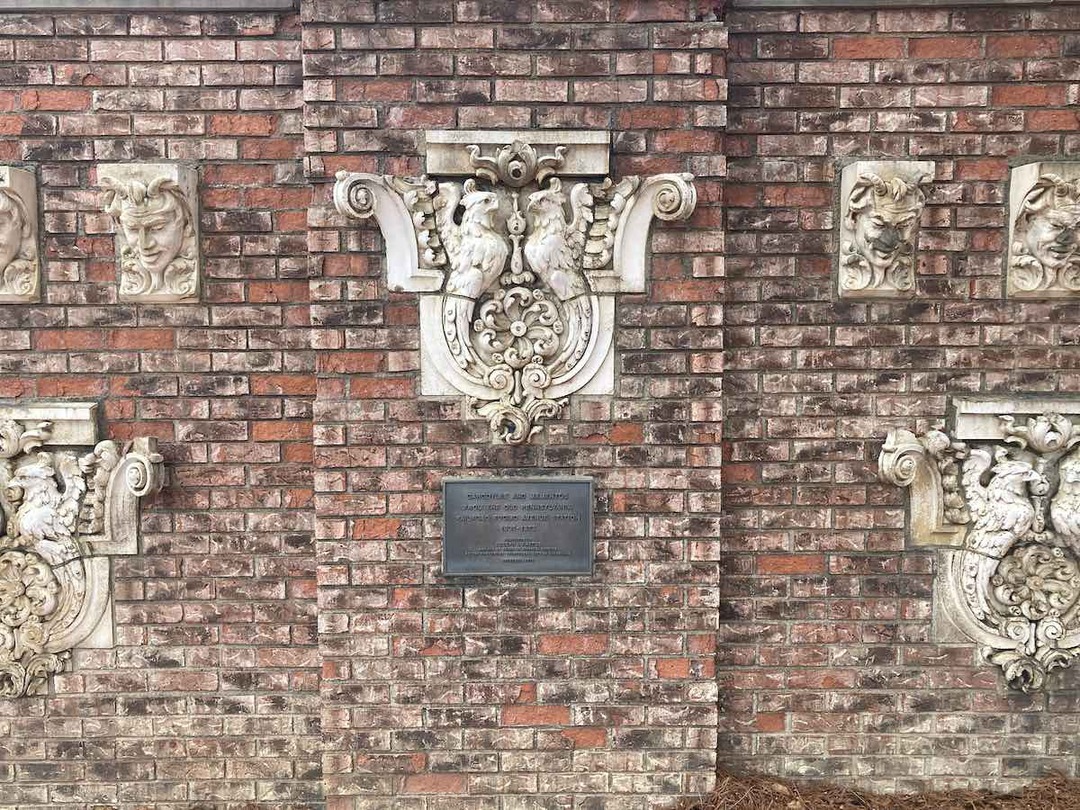
In the early 1910s, at the same time that some public officials were proposing that the future Playhouse Square be named Euclid Square in conscious mimicry of New York's Times Square, the Euclid-East 55th node saw nearby enterprises adopt the name Penn Square. Although the name never quite stuck, it reflected a truth—that the intersection's Pennsylvania Railroad passenger station was an important point of arrival in the city—and has since animated some suggestions to revive the name as part of revitalization efforts.
The Euclid Avenue railway station had its roots in 1856 when the Cleveland & Pittsburgh Railroad Company received a donation of land at the intersection of Euclid and Willson Avenue (East 55th Street from 1906) from Jared V. Willson. The donation of land was also accompanied by $500 given by residents of Euclid Avenue for the purpose of building a new passenger station along the rail tracks. The initial station was designed to have several waiting rooms for passengers as well as offices for railroad agents and station workers. By 1873, the station, by then part of the Pennsylvania Railroad, had been fully furnished with the modern amenities of the time such as gas, water, and bathrooms.
As the new station at Euclid and 55th was built, the street railway was extended to connect with the new station. Due to protest from the wealthy residents of Euclid Avenue who did not want to see their street defaced with tracks, the streetcars ran along Prospect Avenue instead, and at East 40th turned back onto Euclid. The new station became an important hub for passengers from both the streetcar line and the railroad, and quickly became one of the main entry points into the city for visitors and new residents. It was the point of entry for President Lincoln during his stop in Cleveland on his way to Washington in 1860. It was also the starting point for Lincoln’s funeral service in Cleveland in 1865. On September 24, 1881, the body of President James A. Garfield arrived there to be brought to Lake View Cemetery and, in January 1916, President Woodrow Wilson would also visit Cleveland, entering the city through the Euclid Avenue Station.
The Euclid Avenue Station was replaced in 1902 and a new station, located next to the old one, opened that June. The new station had a large waiting area with large glass windows along one side. The other walls were made of white glazed brick, and the floors were laid with mosaic marble. Among the most significant new installations in this new passenger station were electric lights. The new station boasted several electric chandeliers and other electric wall-mounted lights. A new park and driveway took the place of the old station and grounds immediately around it.
By the 1910s the intersection of Euclid Avenue and East 55th had become a disorganized and dangerous mess. Not only was this area the intersection of two major roads, but also two major streetcar lines as well as the crossing for the railroad. With so much traffic from streetcars, automobiles, horse-drawn carts, pedestrians, and trains, Euclid Avenue and East 55th had become one of Cleveland’s busiest and most dangerous intersections. To alleviate some of the traffic, in 1910 the city decided to raise the railroad tracks above the streets. The city had wanted to do this for some time but had been unable to raise the money. But now that the money had been allocated and an agreement with the Pennsylvania Railroad Company had been reached, the project could proceed.
Work on elevating the rails above the streets began in the late summer of 1910. Representatives of the Pennsylvania Railroad assured Cleveland Mayor Herman Baehr that they could have the temporary work done on the new crossings in just eight months' time. In order to get rid of the multiple dangerous intersections as soon as possible, it was planned that the tracks would be raised and then kept in place with temporary rail bridges, thereby allowing the city to proceed with replacing the streets at the same time.
The work on constructing permanent bridges over the roads continued for several more years and was completed in 1915. In order to accommodate passengers with the new elevated tracks at the Euclid Avenue and East 55th Street intersection the passenger station there would have to be renovated. The station was closed on June 13, 1913, and construction on the new station was completed the following March. Contracted to design and build the new station expansion was Chicago-based architectural firm Burnham & Co. (the firm founded by Daniel Burnham who was responsible for the 1893 Chicago World's Fair), and the project was led by an S. Williams. The work to renovate the existing station was extensive as the whole building had to be moved about thirty-nine feet so that it could be incorporated into the supporting concrete walls of the elevated tracks.
The new construction added an additional 9,800 square feet onto the existing structure. The grounds were doubled in size with larger driveways to accommodate more automobiles, more tracks for passenger and baggage railcars, as well as three new parks. The interior had two waiting rooms. The first, the main waiting room, was 5,600 square feet with terrazzo floors, walls which had five feet of white wainscotting with brick above, and a high ceiling with skylights. The other waiting room was desginated the ladies' waiting room and was 693 square feet. The room had the same flooring but with the addition of large rugs, and the walls were a yellow cream color. For furnishing, both rooms had ample seating and individual writing desks. The whole station was equipped with a new announcement system where an announcer could speak into a phone in their office and have their voice heard throughout the station.
In 1953 the Euclid station became the Pennsylvania Railroad Company’s main passenger station to and from Cleveland with the closing of the historic Union Depot on September 27, 1953. The Euclid station remained in use for another decade, eventually closing in 1965. The station’s last day of operation was January 29, 1965. On the final day, crowds of passengers began lining up at 5 p.m. to purchase tickets for the last train. Two faded red signs with CLEVELAND painted in gold on them had been taken from the platform and given away. John E. Eles, a seventeen-year-old Cleveland Heights High School senior, had received one of the signs and was among the final passengers. He had even brought his own engineer’s cap. The last station conductor, W. M. Maholm, age 61, finally signaled to the engineer to leave the station while the train's passengers passed around a bottle of scotch to toast the last run. The train arrived on time at 7:20 p.m. in Youngstown, where a Greyhound bus was waiting to take them back to Cleveland.
In June 1973, the station collapsed as a freight train passed by, and afterwards the rest of the building was demolished. The only section of the station still remaining is the concrete vault that was underneath the tracks. Also still surviving are nine terra-cotta wall statutes that were moved to the Rockefeller Greenhouse for display. There have been several attempts over the years to revitalize the area around the intersection by creating more vibrant parks and pedestrian areas, and turning the area into a new destination, possibly using the name "Penn Square," which evokes earlier places' references to the rail station.
Images








